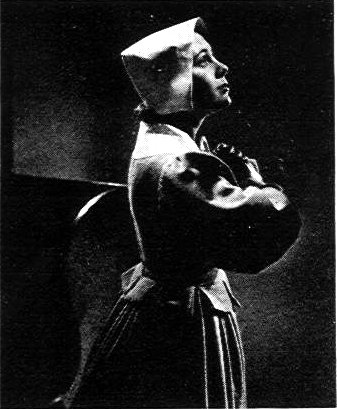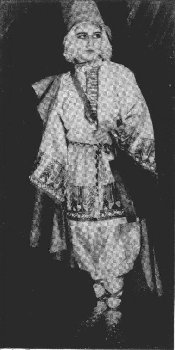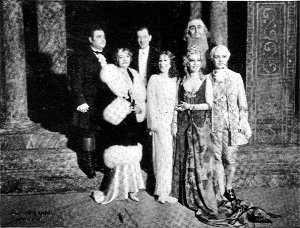Opera Diva
 |
Gladys joined the Chicago Civic Opera company after some of her friends arranged a surprise audition for her. Learning twenty three parts in a matter of months, she had roles in fifty percent of the productions they performed for the next five seasons. Left, Gladys as Stephano in Romeo and Juliet. Right, Gladys in Mignon. |
|
Gladys left Chicago and joined the New York Metropolitan Opera in 1929 where she sang for sixteen years. Her first year with the Met, Gladys sang parts in fifty-six productions, more than any other individual. Along with Lily Pons, she did much to increase the glamour of the opera stars to the general public. She was most famous as Carmen, but she only attempted it once she had reached the peak of her vocal powers. Right - Gladys the first to ever play part of Plentiful Tewes, in Howard Hanson's opera, Merry Mount. |

|
She was well known as Mignon in the opera by Ambroise Thomas of the same name. She performed the role for the Free Milk for Babies opera sponsored by Mrs. William Randolph Hearst. (Front Row) Mrs. Hearst, Lucrezia Bori, Lily Pons and Gladys. (Back Row) Beniamino Gigli, New York City Mayor James Walker and Leon Rothier. |
|
Broadcast Operas
The New York Metropolitan Opera has been broadcasting on Saturday afternoons for decades. The following is a listing of operas that Gladys had parts in as a mezzo-soprano for these broadcasts and came from the Opera House's historical section:
The first every radio broadcast from the New York Met was Hänsel und Gretel, broadcast on Christmas Day 1931.
| Norma Roméo et Juliette - January
26, 1935 Hasselmans: Norena, Swarthout, Wakefield; Hackett, De Luca, Rothier Mignon - March 13, 1937 Pinza Acts III, IV - December 26, 1931 Lakmé - February 27, 1932 Peter Ibbetson (partial) - March 26, 1932 Roméo et Juliette Acts II, III - April 9, 1932
|

Gladys Swarthout as Photo from The Victor Book of the Opera, 1945. |
Mignon - December 30, 1933 Hasselmans: Bori, Pons, Swarthout; Schipa, Rothier Merry Mount by Howard Hanson - February 10, 1934 Faust - February 17, 1934 Peter Ibbetson by Deems Taylor - March 17, 1934
La Forza del Destino - January 19, 1935 |
Opera was not a safe business! Gladys had many interesting encounters in her years on stage. TIME magazine reported the following items over her career. People At a Chicago Civic Opera performance of Mignon, Tito Schipa, supposed to carry Gladys Swarthout off stage, let Désiré Defrère substitute in the job. Proxy Defrère stumbled, dropped her. Explained Slacker Schipa: "She is, you understand, a little heavy, I do not say she is fat, just a little heavy." Retorted Proxy Defrère, "I slipped on a tack. It was only natural I do the job. Schipa is too puny." BERLIOZ: Romeo & Juliet--Dramatic Symphony, Op. 17; Scenes 6-7 from The Damnation of Faust, Op. 24 Gladys Swarthout, soprano February 9, 1947 and February 16, 1947 As early as 1896 Toscanini had expressed interest in the Romeo and Juliet Symphony, and he had already run into opposition to the mounting of a performance, due to the composer's lack of popularity. After numerous programs of Berlioz' overtures and the Queen Mab section of the Romeo score, Toscanini (along with Beecham and Mitropoulos) had instilled, by 1945, some healthy respect for Berlioz' oeuvre, and so the 1947 broadcast became feasible. Gladys Swarthout, who had suffered a broken knee prior to the 9 February performance, sings with a remarkable lightness and buoyancy. |
Gladys As Mignon. |

The last update to the page was on January 30, 2006
Send me some mail!

